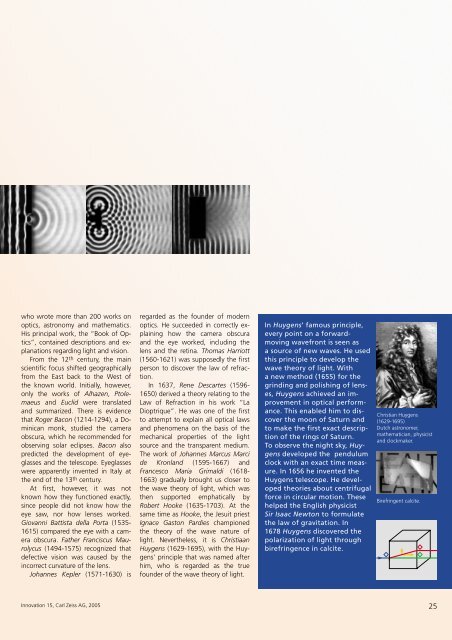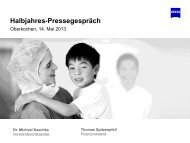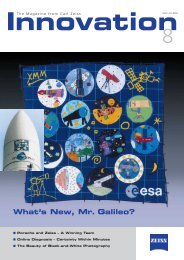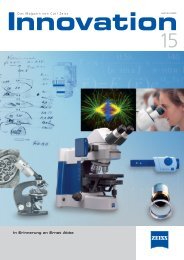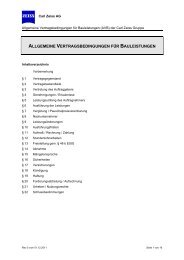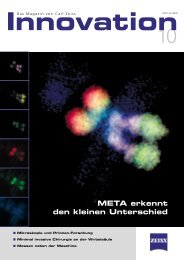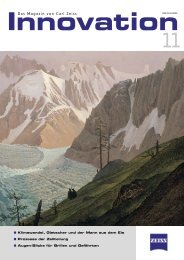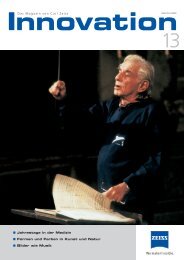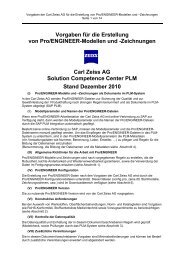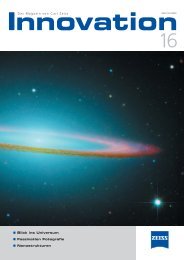Download PDF - Carl Zeiss
Download PDF - Carl Zeiss
Download PDF - Carl Zeiss
You also want an ePaper? Increase the reach of your titles
YUMPU automatically turns print PDFs into web optimized ePapers that Google loves.
who wrote more than 200 works on<br />
optics, astronomy and mathematics.<br />
His principal work, the “Book of Optics”,<br />
contained descriptions and explanations<br />
regarding light and vision.<br />
From the 12 th century, the main<br />
scientific focus shifted geographically<br />
from the East back to the West of<br />
the known world. Initially, however,<br />
only the works of Alhazen, Ptolemaeus<br />
and Euclid were translated<br />
and summarized. There is evidence<br />
that Roger Bacon (1214-1294), a Dominican<br />
monk, studied the camera<br />
obscura, which he recommended for<br />
observing solar eclipses. Bacon also<br />
predicted the development of eyeglasses<br />
and the telescope. Eyeglasses<br />
were apparently invented in Italy at<br />
the end of the 13 th century.<br />
At first, however, it was not<br />
known how they functioned exactly,<br />
since people did not know how the<br />
eye saw, nor how lenses worked.<br />
Giovanni Battista della Porta (1535-<br />
1615) compared the eye with a camera<br />
obscura. Father Franciscus Maurolycus<br />
(1494-1575) recognized that<br />
defective vision was caused by the<br />
incorrect curvature of the lens.<br />
Johannes Kepler (1571-1630) is<br />
Innovation 15, <strong>Carl</strong> <strong>Zeiss</strong> AG, 2005<br />
regarded as the founder of modern<br />
optics. He succeeded in correctly explaining<br />
how the camera obscura<br />
and the eye worked, including the<br />
lens and the retina. Thomas Harriott<br />
(1560-1621) was supposedly the first<br />
person to discover the law of refraction.<br />
In 1637, Rene Descartes (1596-<br />
1650) derived a theory relating to the<br />
Law of Refraction in his work “La<br />
Dioptrique”. He was one of the first<br />
to attempt to explain all optical laws<br />
and phenomena on the basis of the<br />
mechanical properties of the light<br />
source and the transparent medium.<br />
The work of Johannes Marcus Marci<br />
de Kronland (1595-1667) and<br />
Francesco Maria Grimaldi (1618-<br />
1663) gradually brought us closer to<br />
the wave theory of light, which was<br />
then supported emphatically by<br />
Robert Hooke (1635-1703). At the<br />
same time as Hooke, the Jesuit priest<br />
Ignace Gaston Pardies championed<br />
the theory of the wave nature of<br />
light. Nevertheless, it is Christiaan<br />
Huygens (1629-1695), with the Huygens’<br />
principle that was named after<br />
him, who is regarded as the true<br />
founder of the wave theory of light.<br />
In Huygens’ famous principle,<br />
every point on a forwardmoving<br />
wavefront is seen as<br />
a source of new waves. He used<br />
this principle to develop the<br />
wave theory of light. With<br />
a new method (1655) for the<br />
grinding and polishing of lenses,<br />
Huygens achieved an improvement<br />
in optical performance.<br />
This enabled him to discover<br />
the moon of Saturn and<br />
to make the first exact description<br />
of the rings of Saturn.<br />
To observe the night sky, Huygens<br />
developed the pendulum<br />
clock with an exact time measure.<br />
In 1656 he invented the<br />
Huygens telescope. He developed<br />
theories about centrifugal<br />
force in circular motion. These<br />
helped the English physicist<br />
Sir Isaac Newton to formulate<br />
the law of gravitation. In<br />
1678 Huygens discovered the<br />
polarization of light through<br />
birefringence in calcite.<br />
Christian Huygens<br />
(1629-1695)<br />
Dutch astronomer,<br />
mathematician, physicist<br />
and clockmaker.<br />
Birefringent calcite.<br />
25


